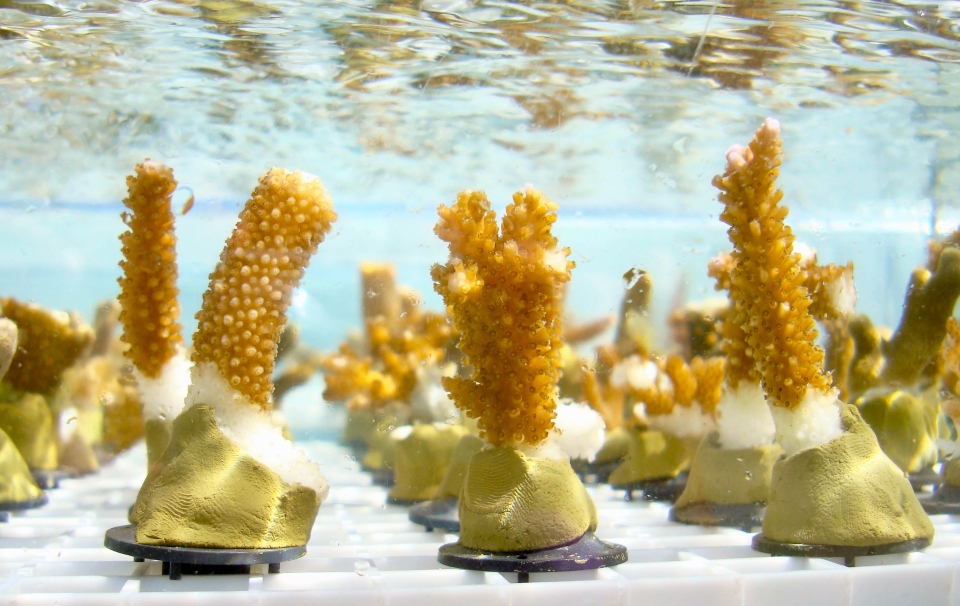Breadcrumbs
- News
- News Archive
- Protecting Coral Reefs

As rising ocean temperatures threaten the health and long-term survival of coral reefs, a new study by researchers from Dominican University of California has identified interventions that can substantially reduce the damage to corals during periods of high water temperature.
The study is published online in the Journal of Experimental Marine Biology and Ecology. The print copy was made available in December 2017.
Corals are extremely sensitive to temperature changes. If the average temperature gets too high, the corals become stressed and expel the symbiotic algae that live inside them. When these beneficial algae are evicted by the corals, the corals in turn become white – or bleached – and often die.
Previous studies have indicated that decreases in solar irradiance can reduce the degree of coral bleaching during periods of high water temperature. This new study evaluates shading as a tool to mitigate coral bleaching during cumulative thermal stress periods, as defined by the National Oceanic and Atmospheric Administration (NOAA) satellite alert system, which warns when a heating period is underway.
“We have known for a long time about the interaction between light and thermal stress, and we know from work in the lab that shading can help corals survive, but what is new in this study is that we are actually examining how useful shading would be as a tool to help corals better cope with stress when higher water temperatures are observed over extended periods of time.” says the study’s lead author Dr. Vania Coelho, professor in Dominican’s Department of Natural Sciences and Mathematics.
The researchers conducted two experiments in American Samoa. One was an aquarium experiment near reef-flat pools in the National Park of American Samoa on Ofu Island, using different levels of shading (none, 50% and 75%) early in conditions of cumulative thermal stress. The second was a field experiment in Tutuila. This shaded/not-shaded platform experiment was carried out in a reef pool in which corals have shown repeated annual summer bleaching for several years.
Shading reduced the degree of bleaching in three species of corals: Acropora muricata, Pocillopora damicornis and Porites cylindrica in American Samoa. In the Ofu experiment, all thermally stressed corals showed less growth than controls, but corals without shading experienced a more substantial decrease in growth compared to those under 50% or 75% shade. The analysis of coral color showed that both levels of shading were protective against bleaching in conditions of cumulative thermal stress for all species, but were particularly beneficial for the most sensitive ones: A. muricata and P. cylindrica. Heavier shading (75%) offered better protection than lighter shading (50%) in this experiment.
In Tutuila, a shaded/not-shaded platform experiment was carried out in a reef pool in which corals have shown repeated annual summer bleaching for several years. This experiment was designed to investigate if shading could attenuate bleaching in the field and also if there were negative consequences to shading removal. The only factor controlled was light intensity, and the main conclusion was that overall corals on the platform became darker than field colonies in response to shading, but adjusted back to the same color level as field colonies after shade removal.
“We could not find any red flags when we removed the shade after several months,” Coelho says. “This is new research and more studies are needed to confirm our findings, but so far we have not seen anything to discourage us from using shade.”
Coelho adds that while it would be impossible to shade wide expanses of reefs, shading could at least protect some reefs – especially those in shallow waters.
“As bleaching becomes more frequent and regular due to global warming, we should consider proactively using shading to help mitigate the effects of thermal stress and prolong the survival of at least some coral communities until solutions to address global climate change become effective.”
Coelho VR, Fenner D, Caruso C, Bayles B, Huang Y, Birkeland C. 2017. Shading as a mitigation tool for coral bleaching in three common Indo-Pacific species. Journal of Experimental Marine Biology and Ecology 497: 152-163.